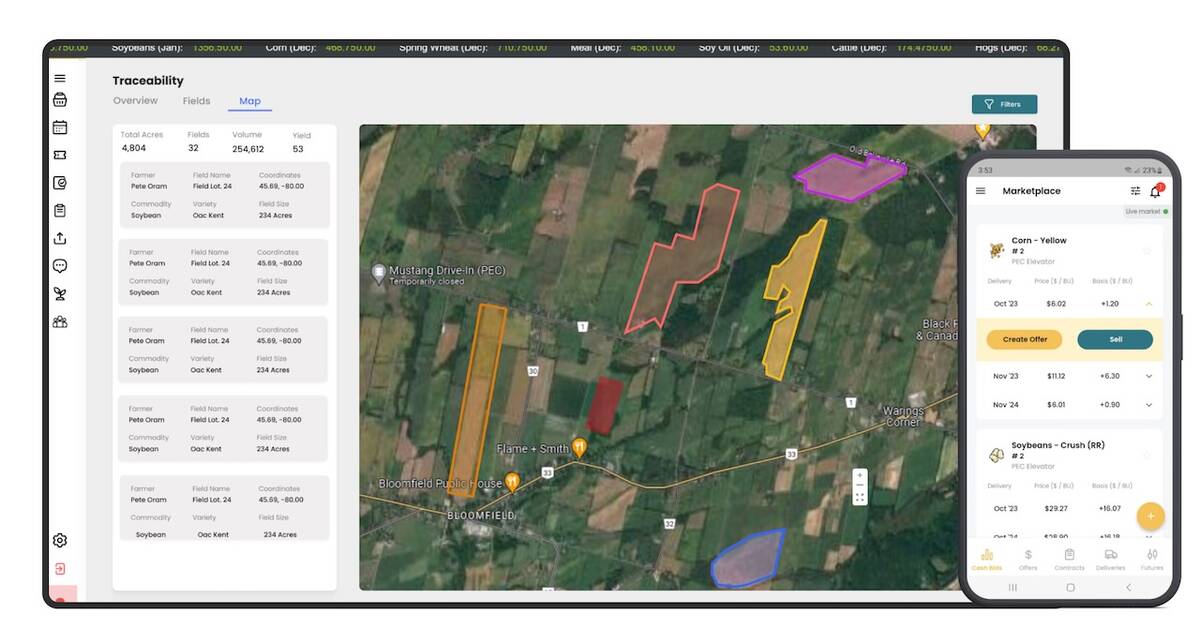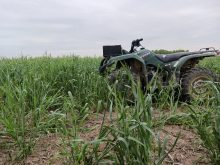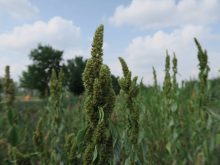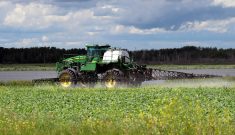Glacier FarmMedia – Spray drift is defined as the off-target movement of pesticide dust or droplets through the air at the time of application or soon after. It can have serious implications for neighbouring farmers and other property owners.
It’s an issue that has been around almost as long as pesticides have been used to protect crops against the threat of weeds, disease and insects. But spray drift has come under increasing scrutiny over the past 10 to 15 years, according to a leading spray expert.
“What has changed is people’s sensitivity to it, socially and otherwise,” says Jason Deveau, an application technology specialist with the Ontario Ministry of Agriculture, Food and Rural Affairs. Deveau is also the co-founder of Sprayers101, a non-profit website, which provides tips and advice on spraying to farmers and applicators.
Read Also

Ontario company Grain Discovery acquired by DTN
Grain Discovery, an Ontario comapny that creates software for the grain value chain, has been acquired by DTN.
“In recent years, there have been products released onto the market that are so potent at tremendously low doses we’ve kind of had the curtain pulled back. You can see the damage or impact of off-target movement you simply couldn’t have seen before,” says Deveau.
There are two primary types of pesticide spray drift — particle drift and vapour drift. Particle drift is the movement of pesticide droplets or solid particles outside of the treatment area. Vapour drift is the movement of pesticide vapours outside of the area being treated.
Deveau says there are two main reasons why pesticide drift has become a greater concern for many farmers.
First, due to the growing awareness and sensitivity of the public to the effects of pesticides on the environment, growers understand the importance of mitigating spray drift risks for the benefit of their neighbours and for environmental stewardship. Second, as a result of the increasing costs of pesticides and other inputs, farmers are looking at ways to decrease spray drift risks to maximize the benefits of the inputs they purchase.
“There’s a very good reason for keeping your pesticide on target,” Deveau explains. “It’s not working for you in your neighbour’s field, it’s not working for you in the lake. It works for you when it goes where it’s supposed to go.”
So, what can a farmer or applicator do if they want to minimize drift when they apply pesticide to a field? Deveau and some Prairie producers offered the following tips.
Apply larger droplets
Deveau says one of the first things you should do is to know your situation and the product you’re using, and to familiarize yourself with any variables you may have to contend with. One rule of thumb to keep in mind is to apply larger droplets if possible, since they are much less likely to drift than smaller droplets.
“Know your product, read your label and pick a nozzle that provides the largest possible droplet that still gives you the biological result you’re looking for,” Deveau says.
Pay attention to weather
Deveau also recommends farmers pay close attention to weather conditions when they are preparing to spray and avail themselves of the latest weather-related technology, including smartphone apps that provide information on everything from relative wind speed to humidity and temperature.
“If you pick good weather conditions, it will improve your odds of reducing drift,” he explains. “If you’re pushing things where it’s too windy or your window for application is short because it won’t stop raining, be very careful because the risks could be much higher that it’s going to blow off course.”
Deveau also advises farmers to be aware of what is happening at adjacent or neighbouring properties, especially when it comes to greenhouses or fields where speciality crops may be grown.
“A lot of products a field cropper might spray could cause a lot of havoc for a speciality crop,” he says. “They should recognize that buying a neighbour’s soybeans if you burn them is far less expensive than buying a neighbour’s grapes.”
Beware of temperature inversions
Although wind can have a large effect on pesticide drift, Deveau cautions farmers not to be fooled into thinking calm conditions mean it’s a good time to spray. He says temperature inversions — a situation in which air near the ground is cooler than the air above it — can contribute to spray drift just as much as strong winds.
Devin Hartzler, who helps run family-owned Triple H Farms near Carstairs, Alta., agrees. He notes temperature inversions start toward evening and can persist until early morning, and they are insidious because they can be difficult to detect.
“You’ll get a temperature inversion and it’s not windy at all and the spray, especially if you’re using a finer water droplet, can hang in the air,” Hartzler says. “Even without wind it can drift, and it can drift farther than if it’s windy out.”
Know your equipment
Deveau stresses the importance of knowing the equipment you will be using to apply pesticide. For example, if you are using a boom sprayer, driving faster tends to necessitate a higher boom so it doesn’t come into contact with the ground. The downside to this is droplets released higher in the air tend to remain in the air for a longer time and are more likely to be picked up by wind.
“Slower spraying means a lower boom, which means less spray is lost,” Deveau says. “If you get the boom a little closer to the ground, you cut down on that time the droplets are in the air.
“Initially, all droplets leaving a nozzle are moving very fast. They could still be moving up to 50 or 60 kilometres per hour when they come out of that nozzle, but they tend to slow down very quickly,” he adds. “You want them to be rocketing into the crop before they slow down and are blown away.”
Of course, spraying with an air blast sprayer is very different than spraying with a horizontal boom. The key with air blast sprayers, according to Deveau, is using only enough air energy to get what you are spraying to the centre of your target.
One of the simplest ways of ensuring that is to perform a test prior to spraying. Tie a ribbon on the opposite and upwind side of a tree and do a couple of sample passes with your sprayer. If the ribbon flutters slightly, that means your travel speed and air energy are in alignment. However, if the ribbon blows straight out that means you are using too much air. No movement of the ribbon means you’re not using enough air or you are driving too fast.
“The nice thing about it is, if you’re willing to take just a few times to do it, you start to build up a reflex response and it becomes second nature,” Deveau says.
Check your sprayer regularly
Hartzler says there are several things his family does to try and minimize pesticide drift on their 4,200-acre grain seed farm north of Calgary.
One of the most important, he says, is to check spraying equipment regularly to make sure it’s operating correctly. That includes eyeballing sprayers while they’re in use in order to detect any changes in the way water droplets are coming out of the nozzles.
“It’s in our best interest to make sure everything is running properly because we don’t want to waste money by having it drift onto somebody else’s field or improperly applying it by being at too high or too low of a rate. Both of those (scenarios) are costly and not beneficial to us,” Hartzler explains.
He also recommends the use of drift retardant compounds when appropriate. Retardants can reduce the risk of spray drift and maximize pesticide performance. The only catch is you have to be careful which ones you use since some are not compatible with some types of spray nozzles.
“It doesn’t eliminate (drift), but it definitely helps,” Hartzler says.
Keep records
Spray drift hasn’t been much of a problem for Triple H Farms since Hartzler joined the family-run operation more than a decade ago. Still, he recommends farmers keep detailed records in case such an event occurs.
Hartzler keeps comprehensive digital and print records of everything from wind direction and speed to temperatures when spraying occurs on the farm in case there is ever an issue on a neighbouring farm.
Not only can such records protect a farmer in the event of a suspected drift, he says, but it also shows they take such situations seriously and are making the effort to prevent them from happening.
Keep up on innovations
Rob Stone and his family farm about 9,000 acres of canola, wheat and lentils on Stone Farms near Davidson, Sask.
Stone says it’s important for farmers to educate themselves as much as possible about the latest developments in spray technology and methodology in order to minimize spray drift. That includes checking out websites like Sprayers101 for recommendations and tips and attending trade shows that offer a first-hand look at the latest innovations in spray technology.
Stone also recommends speaking with neighbouring farmers and other colleagues in the ag community to learn about what has worked for them — and what hasn’t — when it comes to spraying.
“We’ve been implementing and paying attention to as much information out there, which continues to accumulate,” he says. “The good thing is the lifelong learning of application continues to get easier.”
Bill Campbell is a fourth-generation farmer who runs a 2,500-acre mixed farm near Minto, Man.
One of the most common pieces of advice he offers fellow farmers about spraying is to follow the instructions provided on a pesticide’s label in order to learn about the product’s strengths and limitations. Campbell also recommends keeping up to date on innovations taking place in the marketplace, so you know the best options available to you.
“I think there’s great potential for some of that innovation to prevent drift that would go onto adjacent fields,” he says.
Communicate with neighbours
Even though farmers may take all the necessary precautions to prevent pesticides from drifting onto neighbouring properties, there is often little they can do to stop inbound drift from occurring on their own properties.
Stone knows that all too well. He had to file an insurance claim a few years ago when pesticide from a neighbouring farm drifted onto his land. His advice to farmers on how to deal with such a scenario is to be proactive and maintain open lines of communication with their neighbours.
“It’s a simple thing to happen. I think a person needs to remember the shoe can be on the other foot pretty easily when addressing (spray drift),” Stone says. “My personal way to approach it is if you can deal with it in a rational way amongst yourselves and get it sorted out, that’s usually the easiest way.”
– This article was originally published at Grainews.












